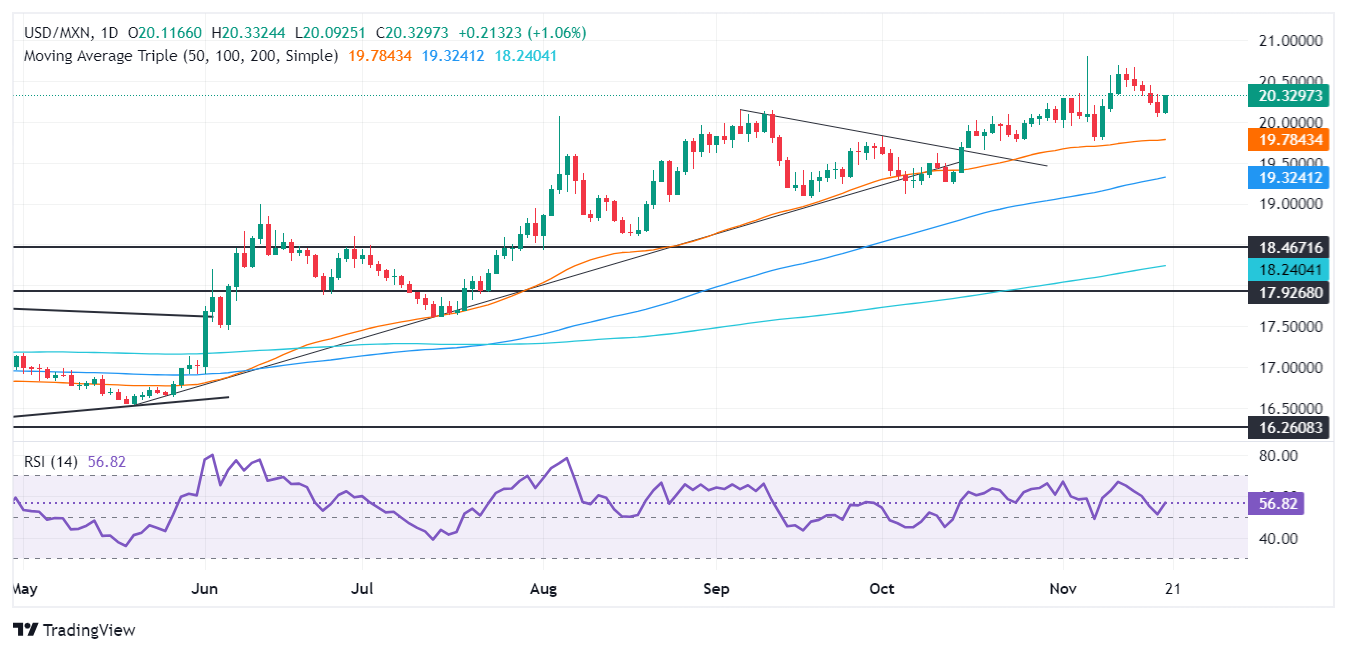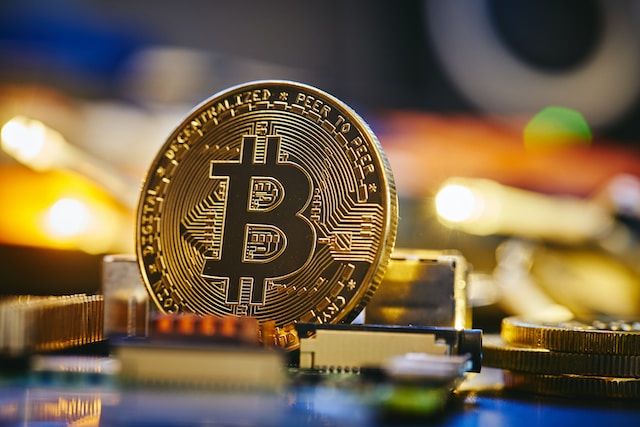Mexican Peso weakens amid geopolitical tensions, dovish Banxico comments
Fxstreet
Nov 20, 2024 6:16 PM
- Mexican Peso erases previous gains on global geopolitical developments and dovish comments from Banxico’s Governor.
- Victoria Rodríguez Ceja’s dovish stance on continued rate cuts reflects efforts to manage inflation amidst economic challenges.
- Geopolitical risks remain heightened as military actions in Ukraine influence USD/MXN’s volatility.
The Mexican Peso erased some of Tuesday's gains versus the Greenback as geopolitical risks continued to drive the financial markets amid a possible escalation of the Russia-Ukraine conflict. Additionally, Bank of Mexico (Banxico) Governor Rodriguez's dovish remarks alongside the ongoing economic slowdown in Mexico hurt the prospects of the emerging market currency. At the time of writing, the USD/MXN trades at 20.30, up by 1%.
Bank of Mexico Governor Victoria Rodríguez Ceja indicated that the central bank plans to continue reducing its benchmark interest rate, citing progress in lowering inflation. Besides this, traders are eyeing the release of Mexican Retail Sales data for September on Thursday, followed by the release of the Gross Domestic Product (GDP) and mid-month inflation figures on Friday.
Meanwhile, some analysts hint that the Mexican economy will not grow within the 2% to 3% range in 2025 as expected by the Finance Ministry. Gabriela Siller of Banco Base said, “It is extremely difficult to achieve GDP growth […] especially in the first year of administration and with cuts in public spending.”
In geopolitics, rising tensions underpinned the USD/MXN as Ukraine fired long-range, British-made missiles into Russian territory. This followed the launch of US-made missiles into Russia on Tuesday.
Aside from this, Federal Reserve (Fed) speakers crossed the wires. First, Governor Lisa Cook said that if the labor market and inflation evolve as expected, it would be appropriate to continue lowering the policy rate toward neutral. She added that if progress on inflation stalls or slows, that would be a scenario for pausing.
Lately, noted hawk Governor Michelle Bowman said the Fed should pursue a cautious approach on monetary policy and added that neutral policy may be closer than most policymakers think.
Ahead this week, the US economic docket will feature the release of Initial Jobless Claims, housing data, and more Fed speakers on Thursday.
Daily digest market movers: Mexican Peso retraces on strong US Dollar
- The USD/MXN soars sharply, boosted by a strong US Dollar. The US Dollar Index (DXY) is up 0.54% at 106.72.
- Mexican Retail Sales for September are expected at 0.1% MoM, unchanged from the previous reading. On a yearly basis, sales are foreseen plunging from -0.8% to -1.2%.
- On Thursday, US Initial Jobless Claims are expected to rise from 217K to 220K for the week ending November 16.
- US Existing Home Sales are projected to rise from 3.854 million to 3.93 million.
- Market participants trimmed estimates for a 25 bps cut by the Fed, with odds falling from 62% to 59%. The odds of keeping rates unchanged are up at 41%, as depicted by the CME FedWatch Tool.
- Data from the Chicago Board of Trade, via the December fed funds rate futures contract, shows investors estimate 23 bps of Fed easing by the end of 2024.
- Last week, Moody’s changed Mexico’s credit outlook to negative, mentioning constitutional reforms that could negatively impact Mexico’s economic and fiscal strength.
USD/MXN technical outlook: Mexican Peso slumps as USD/MXN climbs past 20.30
The USD/MXN uptrend remains intact with buyers stepping in near 20.07, the day’s low, lifting the pair toward the 20.30 mark. A daily close nearby the daily highs would form a “bullish Harami” candlestick pattern and pave the way for further upside.
The next resistance would be the 20.50 figure, followed by the November 12 peak at 20.69. Once those levels are removed, the next resistance would be the year-to-date (YTD) high of 20.80.
On the flip side, the USD/MXN first support would be the 20.00 figure. A breach of the latter will expose the 50-day Simple Moving Average (SMA) and the November 7 low around 19.75, followed by the 19.50 mark.
Oscillators like the Relative Strength Index (RSI) remain bullish though short-term, suggesting some consolidation before buyers gather steam.

Mexican Peso FAQs
The Mexican Peso (MXN) is the most traded currency among its Latin American peers. Its value is broadly determined by the performance of the Mexican economy, the country’s central bank’s policy, the amount of foreign investment in the country and even the levels of remittances sent by Mexicans who live abroad, particularly in the United States. Geopolitical trends can also move MXN: for example, the process of nearshoring – or the decision by some firms to relocate manufacturing capacity and supply chains closer to their home countries – is also seen as a catalyst for the Mexican currency as the country is considered a key manufacturing hub in the American continent. Another catalyst for MXN is Oil prices as Mexico is a key exporter of the commodity.
The main objective of Mexico’s central bank, also known as Banxico, is to maintain inflation at low and stable levels (at or close to its target of 3%, the midpoint in a tolerance band of between 2% and 4%). To this end, the bank sets an appropriate level of interest rates. When inflation is too high, Banxico will attempt to tame it by raising interest rates, making it more expensive for households and businesses to borrow money, thus cooling demand and the overall economy. Higher interest rates are generally positive for the Mexican Peso (MXN) as they lead to higher yields, making the country a more attractive place for investors. On the contrary, lower interest rates tend to weaken MXN.
Macroeconomic data releases are key to assess the state of the economy and can have an impact on the Mexican Peso (MXN) valuation. A strong Mexican economy, based on high economic growth, low unemployment and high confidence is good for MXN. Not only does it attract more foreign investment but it may encourage the Bank of Mexico (Banxico) to increase interest rates, particularly if this strength comes together with elevated inflation. However, if economic data is weak, MXN is likely to depreciate.
As an emerging-market currency, the Mexican Peso (MXN) tends to strive during risk-on periods, or when investors perceive that broader market risks are low and thus are eager to engage with investments that carry a higher risk. Conversely, MXN tends to weaken at times of market turbulence or economic uncertainty as investors tend to sell higher-risk assets and flee to the more-stable safe havens.





